Difference between revisions of "Heart Rate Reserve"
User:Fellrnr (User talk:Fellrnr | contribs) |
User:Fellrnr (User talk:Fellrnr | contribs) m (comment: batch update) |
||
| Line 1: | Line 1: | ||
{{DISPLAYTITLE:Heart Rate Reserve (HRR)}} | {{DISPLAYTITLE:Heart Rate Reserve (HRR)}} | ||
| − | [[File:HeartRateSimplified. | + | [[File:HeartRateSimplified.svg|right|thumb|500px|A simplified chart of heart rate against exercise intensity showing [[Maximum Heart Rate]], [[Heart Rate Reserve]], [[Resting Heart Rate]], [[Orthostatic Heart Rate]], and [[Heart Rate Deflection]].]] |
| − | Heart Rate Reserve (HRR) is the difference between your [[Maximum Heart Rate]] (HR<sub>max</sub>) and [[Resting Heart Rate]] (HR<sub>rest</sub>). Exercise intensity can be evaluated by calculating your heart rate as a percentage of HRR. The calculation to work out %HRR is (HR<sub>ex</sub> – HR<sub>rest</sub>)/(HR<sub>max</sub> – HR<sub>rest</sub>), where HR<sub>ex</sub> is the exercise Heart Rate. So a HR<sub>max</sub> of 180, a HR<sub>rest</sub> of 40 and HR<sub>ex</sub> of 140 would be (140 – 40)/(180 – 40), which is 71%. Using %HRR is better than a percentage of HR<sub>max</sub>, as it reflects the relative intensity more accurately. For example, if two athletes both have a HR<sub>max</sub> of 180, but one has a HR<sub>rest</sub> of 40 and the other 70, at a HR of 140 they would both have the same %HR<sub>max</sub>, but one is at 64 %HRR and the other is at 71 %HRR. | + | Heart Rate Reserve (HRR) is normally calculated as the difference between your [[Maximum Heart Rate]] (HR<sub>max</sub>) and [[Resting Heart Rate]] (HR<sub>rest</sub>). Exercise intensity can be evaluated by calculating your heart rate as a percentage of HRR. The calculation to work out %HRR is (HR<sub>ex</sub> – HR<sub>rest</sub>)/(HR<sub>max</sub> – HR<sub>rest</sub>), where HR<sub>ex</sub> is the exercise Heart Rate. So a HR<sub>max</sub> of 180, a HR<sub>rest</sub> of 40 and HR<sub>ex</sub> of 140 would be (140 – 40)/(180 – 40), which is 71%. Using %HRR is better than a percentage of HR<sub>max</sub>, as it reflects the relative intensity more accurately. For example, if two athletes both have a HR<sub>max</sub> of 180, but one has a HR<sub>rest</sub> of 40 and the other 70, at a HR of 140 they would both have the same %HR<sub>max</sub>, but one is at 64 %HRR and the other is at 71 %HRR. While HRR is a good way of looking at effort and intensity, but there are two issues to be aware of. |
| + | # For HRR to be of value, you have to test your HR<sub>max</sub>, as it '''cannot''' be calculated. Calculating HR<sub>max</sub> is a mistake that can lead to misleading views of effort. | ||
| + | # I believe we should use the [[Orthostatic Heart Rate]] (HR<sub>orth</sub>)which is the [[Heart Rate]] when standing rather than HR<sub>rest</sub>, as HR<sub>orth</sub> is typically 10-15 beats higher than HR<sub>rest</sub>, which is enough to skew the relative effort percentage. | ||
| + | Most [[Heart Rate Monitor]]s will display your %HRR if you input your HR<sub>max</sub> and HR<sub>rest</sub>. | ||
=See Also= | =See Also= | ||
* [[Maximum Heart Rate]] | * [[Maximum Heart Rate]] | ||
Revision as of 16:56, 6 February 2019

Heart Rate Reserve (HRR) is normally calculated as the difference between your Maximum Heart Rate (HRmax) and Resting Heart Rate (HRrest). Exercise intensity can be evaluated by calculating your heart rate as a percentage of HRR. The calculation to work out %HRR is (HRex – HRrest)/(HRmax – HRrest), where HRex is the exercise Heart Rate. So a HRmax of 180, a HRrest of 40 and HRex of 140 would be (140 – 40)/(180 – 40), which is 71%. Using %HRR is better than a percentage of HRmax, as it reflects the relative intensity more accurately. For example, if two athletes both have a HRmax of 180, but one has a HRrest of 40 and the other 70, at a HR of 140 they would both have the same %HRmax, but one is at 64 %HRR and the other is at 71 %HRR. While HRR is a good way of looking at effort and intensity, but there are two issues to be aware of.
- For HRR to be of value, you have to test your HRmax, as it cannot be calculated. Calculating HRmax is a mistake that can lead to misleading views of effort.
- I believe we should use the Orthostatic Heart Rate (HRorth)which is the Heart Rate when standing rather than HRrest, as HRorth is typically 10-15 beats higher than HRrest, which is enough to skew the relative effort percentage.
Most Heart Rate Monitors will display your %HRR if you input your HRmax and HRrest.